New Vrindavan: Origins and Growth
In 1968, New Vrindavan was started by two of Prabhupada's early disciples
- Kirtanananda Swami and Hayagriva das. They and a handful of
devotees settled on 130 acres of land which they procured on a 99 year
lease. On the hillside stood a late 19th century farm house with no
electricity nor running water. Soon, other cabins were built.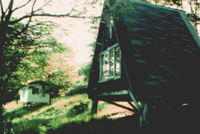
The purpose of New Vrindavan, as Prabhupada succinctly put it, was "To
erect for the members of ISKCON and for society at large a holy place of
transcendental pastimes dedicated to the personality of Krishna." Srila
Prabhupada had a vision of "seven temples on the seven hills," and he
also gave them guidelines for a rural, self sufficient community where
his students would learn to work the land with oxen, and tend to the
cows. As he put it "they should be completely dependent upon nature's
beauty and nature's protection." There he also wanted to establish "a
school for educating brahmanas and Vaisnavas."
Within a few years, other property was purchased to expand the
community. Soon the devotees were getting vegetables and fruits from
mother earth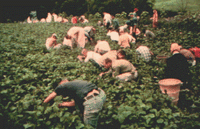 and getting their milk from mother cow. The ladies in the community cooked the meals, churned the butter, and
ran a nursery school for the children.
and getting their milk from mother cow. The ladies in the community cooked the meals, churned the butter, and
ran a nursery school for the children.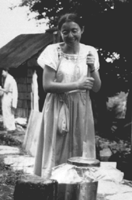 The men milked the cows,
worked oxen and horses to till the land, and gathered the firewood.
The men milked the cows,
worked oxen and horses to till the land, and gathered the firewood.
The devotees would all rise early for daily morning services and read
from the scriptures of India. Their motto: Simple Living and High
Thinking.* These ingredients were Sri Krishna's design for the basis of a
peaceful society as exemplified in the village of Vrindavan, India. 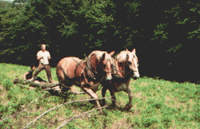 There, over five thousand years ago, Krishna engaged in His
transcendental childhood pastimes with the cowherd boys and girls. To
this day Vrindavan draws hundreds of thousands of pilgrims from
throughout India and across the world. Thus, Prabhupada named his first
rural project in America New Vrindavan.
There, over five thousand years ago, Krishna engaged in His
transcendental childhood pastimes with the cowherd boys and girls. To
this day Vrindavan draws hundreds of thousands of pilgrims from
throughout India and across the world. Thus, Prabhupada named his first
rural project in America New Vrindavan.
The main part of the community throughout the 70's and early 80's was
Bahulaban. That property was purchased in 1971. The original farm
house was painted pink and a wing was added on as a temple. By 1974 a
barn had been built to accommodate the growing dairy herd and the second
floor was sectioned off into small rooms to provide living quarters for
devotees. Within three years, two other large buildings had been
constructed 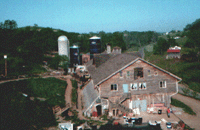 to house both the influx of devotees and the
workshops to facilitate the construction of the Palace of Gold. The
Palace site was two miles up the road from Bahulaban. By the time the
Palace of Gold opened in Sept of 1979, the community had grown to 150
residents and over 1200 acres of land.
to house both the influx of devotees and the
workshops to facilitate the construction of the Palace of Gold. The
Palace site was two miles up the road from Bahulaban. By the time the
Palace of Gold opened in Sept of 1979, the community had grown to 150
residents and over 1200 acres of land.
Upon completion of the Palace the devotees tasted acclaim and success
from within ISKCON and the public in general. The Palace soon became one
of the largest attractions in West Vriginia.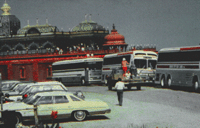 The devotees threw
themselves passionately into a period of building.
The devotees threw
themselves passionately into a period of building.
When asked about farm equipment, Prabhupada had once written: "So far as
your utilizing machinery at New Vrindaban, if such machinery is helpful
than you may take advantage of them. We are not enemies of machines. If
they can be used for Krishna's service then we welcome them." During the
80's all sorts of new construction equipment and machinery appeared in
the community. The quality of work had gone from this
In 1981, an area a half mile past the Palace of Gold had been designated
for a new complex. Within two years the devotees built a 40 room guest
lodge and a three story temple building used for both worship and
residential quarters for devotees. 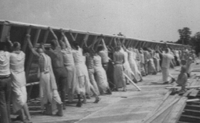 Kirtanananda planned this building
only as an interim temple, and promised the Hindu congregation in America
that New Vrindavan would soon construct a traditional Vedic (Indian)
temple on a very grand scale. Even local and state politicians were
excited about the possibility of new jobs and more tourism for the area.
After the success of the Palace people assumed that New Vrindavan would
deliver.
Kirtanananda planned this building
only as an interim temple, and promised the Hindu congregation in America
that New Vrindavan would soon construct a traditional Vedic (Indian)
temple on a very grand scale. Even local and state politicians were
excited about the possibility of new jobs and more tourism for the area.
After the success of the Palace people assumed that New Vrindavan would
deliver.
The complex near the Palace also included a lake surrounded by swans
and peacocks, a dozen guest cabins, a road system around the complex
paved with bricks made in the community, as well as a nursery and play
ground for preschoolers. This complex became the center of the
community. In 1985 an apartment house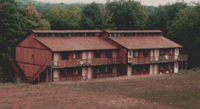 was also built near the temple
to accommodate the expanding population, which had grown to over 600
residents - men, women and children. A basketball court and play ground
were built nearby for the youngsters. The community was expanding so
rapidly and included so many projects, the devotees could no longer do
the work themselves. By the mid 1980's NV had become one of the largest
employers in the county, with over 150 people from the surrounding area
on the payroll. For several years the community even had a pet elephant imported from India.
was also built near the temple
to accommodate the expanding population, which had grown to over 600
residents - men, women and children. A basketball court and play ground
were built nearby for the youngsters. The community was expanding so
rapidly and included so many projects, the devotees could no longer do
the work themselves. By the mid 1980's NV had become one of the largest
employers in the county, with over 150 people from the surrounding area
on the payroll. For several years the community even had a pet elephant imported from India.

Additional Images
1
2
3
4
5
6
7
8

